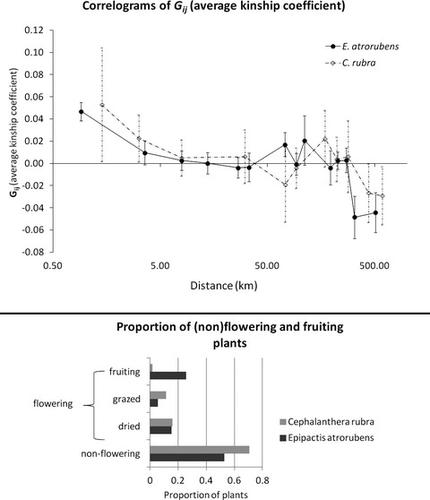当前位置:
X-MOL 学术
›
Plant Biol.
›
论文详情
Our official English website, www.x-mol.net, welcomes your feedback! (Note: you will need to create a separate account there.)
Seed dispersal and realized gene flow of two forest orchids in a fragmented landscape.
Plant Biology ( IF 3.9 ) Pub Date : 2020-03-12 , DOI: 10.1111/plb.13099 M Kotilínek 1 , T Těšitelová 1 , J Košnar 1 , P Fibich 1, 2 , L Hemrová 2 , P Koutecký 1 , Z Münzbergová 2, 3 , J Jersáková 1
Plant Biology ( IF 3.9 ) Pub Date : 2020-03-12 , DOI: 10.1111/plb.13099 M Kotilínek 1 , T Těšitelová 1 , J Košnar 1 , P Fibich 1, 2 , L Hemrová 2 , P Koutecký 1 , Z Münzbergová 2, 3 , J Jersáková 1
Affiliation

|
Species with vast production of dust-like windborne seeds, such as orchids, should not be limited by seed dispersal. This paradigm, however, does not fit recent studies showing that many sites suitable for orchids are unoccupied and most seeds land close to their maternal plant. To explore this issue, we studied seed dispersal and gene flow of two forest orchid species, Epipactis atrorubens and Cephalanthera rubra, growing in a fragmented landscape of forested limestone hills in southwest Bohemia, Czech Republic. We used a combination of seed trapping and plant genotyping methods (microsatellite DNA markers) to quantify short- and long-distance dispersal, respectively. In addition, seed production of both species was estimated. We found that most seeds landed very close to maternal plants (95% of captured seeds were within 7.2 m) in both species, and dispersal distance was influenced by forest type in E. atrorubens. In addition, C. rubra showed clonal reproduction (20% of plants were of clonal origin) and very low fruiting success (only 1.6% of plants were fruiting) in comparison with E. atrorubens (25.7%). Gene flow was frequent up to 2 km in C. rubra and up to 125 km in E. atrorubens, and we detected a relatively high dispersal rate among regions in both species. Although both species occupy similar habitats and have similar seed dispersal abilities, C. rubra is notably rarer in the study area. Considerably low fruiting success in this species likely limits its gene flow to longer distances and designates it more sensitive to habitat loss and fragmentation.
中文翻译:

在一个破碎的景观中,两种森林兰花的种子传播和实现的基因流。
大量产生粉尘状风生种子的物种,例如兰花,不应受到种子扩散的限制。但是,这种范例不适用于最近的研究,该研究表明,许多适合兰花的地点都没有人居住,并且大多数种子都靠近其母本植物着陆。为了探讨这个问题,我们研究了捷克波西米亚西南部森林石灰岩丘陵的零散景观中生长的两种森林兰花物种Epipactis atrorubens和Cephalanthera rubra的种子传播和基因流。我们结合了种子捕获和植物基因分型方法(微卫星DNA标记),分别对短距离和长距离分散进行定量。另外,估计了两种物种的种子产量。我们发现,在两种物种中,大多数种子着陆的位置都非常接近母本植物(捕获的种子中有95%位于7.2 m之内),铜绿假单胞菌的森林类型影响其扩散距离。此外,与金绿假单胞菌(25.7%)相比,红景天(C. rubra)显示出克隆繁殖(20%的植物是克隆起源的)和极低的结实成功率(仅1.6%的植物有结果)。基因流动在红毛菜中最常见,可达2 km,在金黄色芽孢杆菌中最高达125 km,我们在这两个物种的区域之间均发现了相对较高的分散速率。尽管两个物种都具有相似的栖息地,并且具有相似的种子传播能力,但是在研究区域中,红毛锦葵明显稀少。该物种的成功率极低,可能会将其基因流限制在更长的距离,并使其对生境的丧失和破碎更加敏感。洋紫菜显示出无性繁殖(20%的植物是克隆起源的)和成功的结果成功率较低(仅1.6%的植物有结果),而阿奇霉素则为25.7%。基因流动在红毛菜中最常见,可达2 km,在金黄色芽孢杆菌中最高达125 km,我们在这两个物种的区域之间均发现了相对较高的分散速率。尽管两个物种都具有相似的栖息地,并且具有相似的种子传播能力,但是在研究区域中,红毛锦葵明显稀少。该物种的成功率极低,可能会将其基因流限制在更长的距离,并使其对生境的丧失和破碎更加敏感。洋紫菜显示出无性繁殖(20%的植物是无性系),结果成功率较低(仅1.6%的植物有结果),而阿奇霉素则为25.7%。基因流动在红毛菜中最常见,可达2 km,在金黄色芽孢杆菌中最高达125 km,我们在这两个物种的区域之间均发现了相对较高的分散速率。尽管两个物种都具有相似的栖息地,并且具有相似的种子传播能力,但是在研究区域中,红毛锦葵明显稀少。该物种的成功率极低,可能会将其基因流限制在更长的距离,并使其对生境的丧失和破碎更加敏感。并且我们在两个物种的区域之间发现了相对较高的分散率。尽管两个物种都具有相似的栖息地,并且具有相似的种子传播能力,但是在研究区域中,红毛锦葵明显稀少。该物种的成功率极低,可能会将其基因流限制在更长的距离,并使其对生境的丧失和破碎更加敏感。并且我们在两个物种的区域之间发现了相对较高的分散率。尽管两个物种都具有相似的栖息地,并且具有相似的种子传播能力,但是在研究区域中,红毛锦葵明显稀少。该物种的成功率极低,可能会将其基因流限制在更长的距离,并使其对生境的丧失和破碎更加敏感。
更新日期:2020-03-12
中文翻译:

在一个破碎的景观中,两种森林兰花的种子传播和实现的基因流。
大量产生粉尘状风生种子的物种,例如兰花,不应受到种子扩散的限制。但是,这种范例不适用于最近的研究,该研究表明,许多适合兰花的地点都没有人居住,并且大多数种子都靠近其母本植物着陆。为了探讨这个问题,我们研究了捷克波西米亚西南部森林石灰岩丘陵的零散景观中生长的两种森林兰花物种Epipactis atrorubens和Cephalanthera rubra的种子传播和基因流。我们结合了种子捕获和植物基因分型方法(微卫星DNA标记),分别对短距离和长距离分散进行定量。另外,估计了两种物种的种子产量。我们发现,在两种物种中,大多数种子着陆的位置都非常接近母本植物(捕获的种子中有95%位于7.2 m之内),铜绿假单胞菌的森林类型影响其扩散距离。此外,与金绿假单胞菌(25.7%)相比,红景天(C. rubra)显示出克隆繁殖(20%的植物是克隆起源的)和极低的结实成功率(仅1.6%的植物有结果)。基因流动在红毛菜中最常见,可达2 km,在金黄色芽孢杆菌中最高达125 km,我们在这两个物种的区域之间均发现了相对较高的分散速率。尽管两个物种都具有相似的栖息地,并且具有相似的种子传播能力,但是在研究区域中,红毛锦葵明显稀少。该物种的成功率极低,可能会将其基因流限制在更长的距离,并使其对生境的丧失和破碎更加敏感。洋紫菜显示出无性繁殖(20%的植物是克隆起源的)和成功的结果成功率较低(仅1.6%的植物有结果),而阿奇霉素则为25.7%。基因流动在红毛菜中最常见,可达2 km,在金黄色芽孢杆菌中最高达125 km,我们在这两个物种的区域之间均发现了相对较高的分散速率。尽管两个物种都具有相似的栖息地,并且具有相似的种子传播能力,但是在研究区域中,红毛锦葵明显稀少。该物种的成功率极低,可能会将其基因流限制在更长的距离,并使其对生境的丧失和破碎更加敏感。洋紫菜显示出无性繁殖(20%的植物是无性系),结果成功率较低(仅1.6%的植物有结果),而阿奇霉素则为25.7%。基因流动在红毛菜中最常见,可达2 km,在金黄色芽孢杆菌中最高达125 km,我们在这两个物种的区域之间均发现了相对较高的分散速率。尽管两个物种都具有相似的栖息地,并且具有相似的种子传播能力,但是在研究区域中,红毛锦葵明显稀少。该物种的成功率极低,可能会将其基因流限制在更长的距离,并使其对生境的丧失和破碎更加敏感。并且我们在两个物种的区域之间发现了相对较高的分散率。尽管两个物种都具有相似的栖息地,并且具有相似的种子传播能力,但是在研究区域中,红毛锦葵明显稀少。该物种的成功率极低,可能会将其基因流限制在更长的距离,并使其对生境的丧失和破碎更加敏感。并且我们在两个物种的区域之间发现了相对较高的分散率。尽管两个物种都具有相似的栖息地,并且具有相似的种子传播能力,但是在研究区域中,红毛锦葵明显稀少。该物种的成功率极低,可能会将其基因流限制在更长的距离,并使其对生境的丧失和破碎更加敏感。


























 京公网安备 11010802027423号
京公网安备 11010802027423号